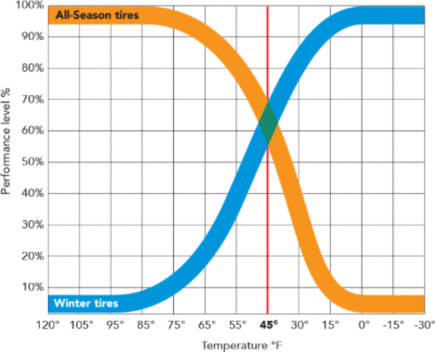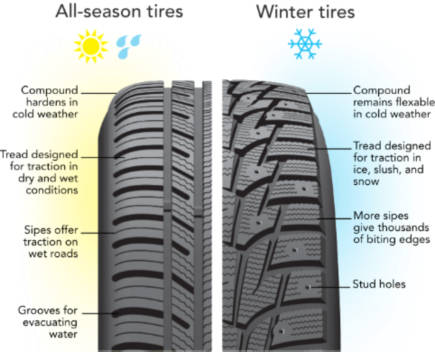It is a common misconception that all-season tires will deliver the same performance results as winter tires (or “snow tires”). This is false as winter tires are drastically different from all-season tires in both construction and functionality. The temperature range and road conditions that they operate at are different.
Rubber Compounds
A major difference between winter and all-season tires is the rubber compound used to make them. The rubber compound in winter tires is engineered to deliver the best possible traction in wet, dry, slush, snow or icy conditions. Winter tires have a temperature range where they operate at optimum performance because of this compound. Most winter tires have rubber compounds with one or more of these features:
- All winter tires use a tread compound that will remain flexible below 45 degrees, allowing them to retain traction.
- Some winter tires utilize small "bite particles" which act almost like studs, adding extra grip for icy road conditions.
- Some winter compounds use silica-based micropore compounds that give additional traction through surface water in icy areas.

The compounds that make up all-season tires are designed to perform well in more moderate conditions, particularly when temperatures are warmer.
- All-season rubber compounds stiffen as temperatures drop By the time they drop below 45 degrees, they start to lose traction which makes braking, acceleration and cornering less reliable and more difficult.
- All-season rubber compounds are optimized for longevity and ride comfort. This is great for spring, summer, and fall driving, but it makes winter driving unreliable at best, and dangerous at worst.
Tread Pattern
A winter tire's tread pattern is a very important factor in gaining safer traction in cold weather conditions.
- Wide circumferential grooves enhance traction in slush and snow by rapidly ejecting buildup from the contact patch of the tire.
- Smaller shoulder blocks increase the number of biting edges for grip in snow and ice, without impairing handling or ride comfort.
- Highly dense sipe patterns add thousands of extra biting edges, increasing grip in icy conditions.

All-season tread patterns however are designed to give good wet-weather grip, dry traction and handling with only minimal winter capability. The variety of seasonal driving necessities leads to compromises that make all-season tires less effective in the highly specialized requirements of winter driving. These compromises include:
- Large, wide shoulder blocks are optimized for superior cornering, wear and all-season traction that provide less grip in snow and ice.
- Smooth tread patterns provide highway comfort and uneven tread wear resistance which are not effective at ejecting snow and slush from the contact patch.
- Minimal siping compared to winter tires which reduces ice traction, which requires significantly more siping for optimal winter grip.
Winter/Snow Tire Safety


* Winter tires maintain flexibility and road grip when temperatures drop below 45 degrees.
** Stopping distance gets longer with less tread depth.
Three-peak Mountain Snowflake Symbol

For absolute certainty that your tire is winter-capable, check for the Three Peak Mountain Snowflake symbol. This is a severe weather symbol that is displayed on the sidewall of your tires and it means that they have been tested to meet or exceed standards set by the U.S. Tire Manufacturers Association (USTMA) for traction in snow.
If you regularly deal with snow and ice or temperatures consistently below 45 degrees, winter-rated tires are the safest bet for you and your vehicle, even if conditions are dry. We recommend installing winter tires early to avoid the rush and be safe for as long as possible.
If you deal with severe winter weather conditions, then you might want to consider high-performance winter tires.
Also, it can be beneficial to keep a set of winter wheels as well. This makes it easier to change to season-appropriate tires and saves your regular wheels the wear and tear of icy, salty roads.
WE KNOW WINTER/SNOW TIRES AT AMERICA'S TIRE
America's Tire has a huge stock of winter and snow-rated tires for you to choose from. If you’re overwhelmed with our huge inventory, we got you covered. Look for tires on Treadwell, our intuitive tire buyer’s guide that uses data like your daily commute style, region, vehicle make and model and budget to show you the best tires for you.
We also offer winter tire changeover services so you can sit back, relax and enjoy the winter season yourself.
You can drop by any of your local America's Tire store locations for a consultation, purchase or installation.
Get a shorter wait time in-store when you buy and book online!
